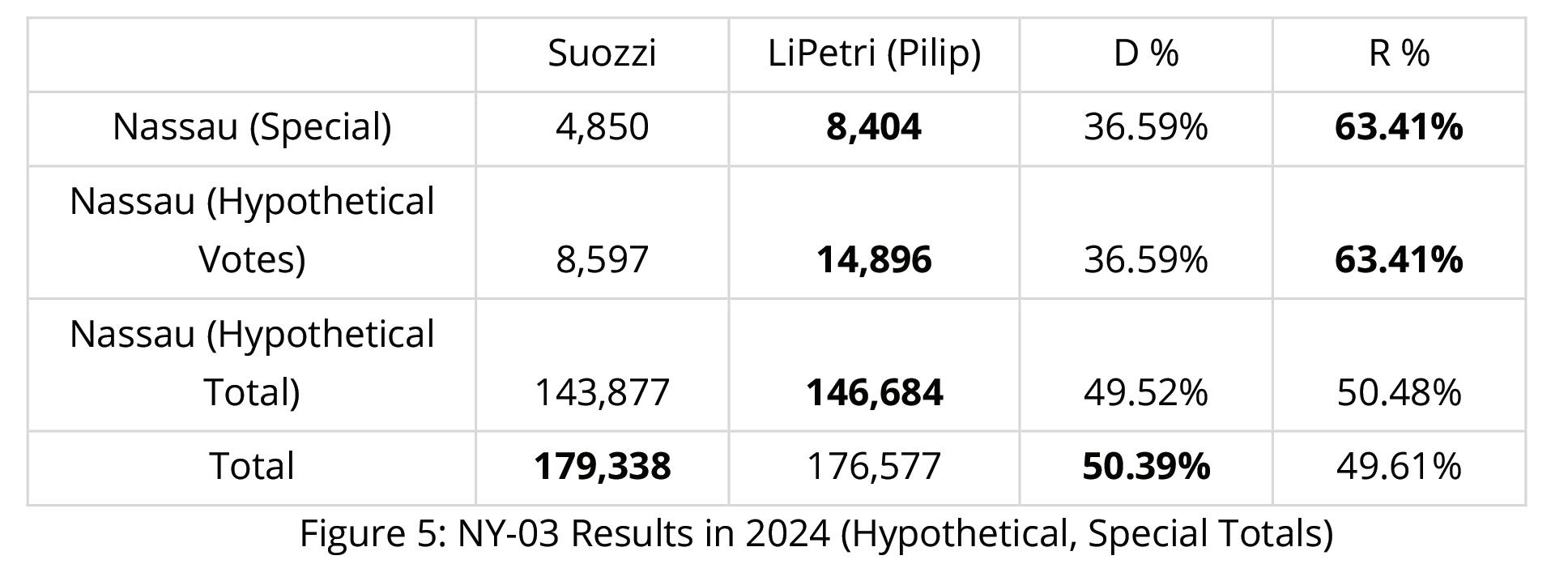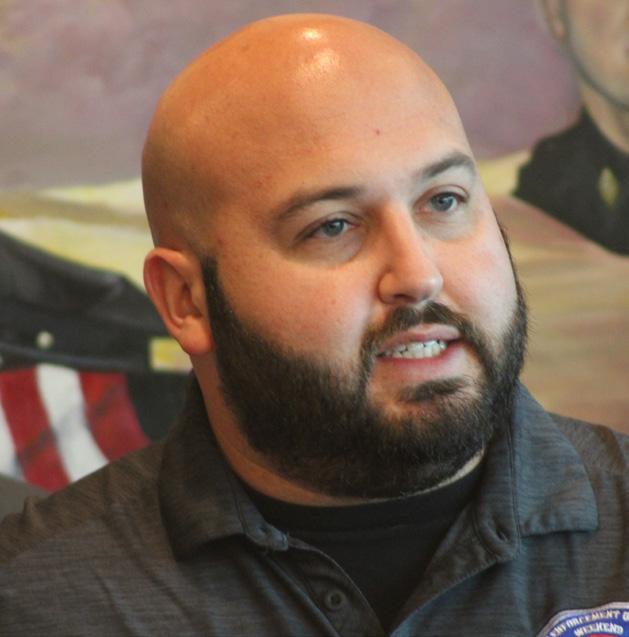






By Matt Meduri
On January 5, Suffolk County Police Department (SCPD) Officer Brendon Gallagher was involved in a crash that nearly ended his life. He was pursuing a driver who was going over 100mph while high on the Long Island Expressway. The intoxicated driver crashed into Gallagher’s vehicle, sending him off the highway near Exit 55 leaving him trapped. Gallagher was trapped in his car for forty-five minutes before he was transported to Stony Brook Hospital where he would spend twentytwo days recovering, nine of them on life support.
Gallagher’s recovery was considered “miraculous” by many, notably by Dr. James Vosswinkel, SBUH’s Chief of Trauma, Emergency Surgery, and Surgical Critical Care Division. Vosswinkel memorably said that the term “miraculous” is often overstated in serious cases, but not Gallagher’s.
Continued on page 11




The Town of Islip Department of Parks, Recreation and Cultural Affairs held its annual Sharpshooter Basketball competition recently, a tradition that brings together children in fourth and fifth grade from across Islip Town for some friendly competition and to help promote drug and alcohol awareness.
Students and family gathered at East Islip High School for this tournament and competed to see who would make the most hoops after hearing about the history of the contest and words of encouragement from The Town Supervisor, Angie Carpenter.
Continued on page 10


PUBLISHER
Diane Caudullo EDITOR-IN-CHIEF
Matt Meduri
STAFF
Cait Crudden
Raheem Soto ART
Sergio A. Fabbri
GRAPHIC
Colin Herr
CONTRIBUTORS
PJ Balzer
Ashley Pavlakis


Published by Messenger Papers, Inc.
Thursday, March 27, 2025
By Matt Meduri


A yearly tradition not missed by many, Lake Ronkonkoma held yet another successful St. Patrick’s Day Parade.
Originating at the AMVETS Post #48 at Church Street and Hawkins Avenue, the cavalcade of community groups, officials, and businesses made their way down Hawkins Avenue at 2:00p.m.
Irish-themed floats and displays such as Irish Eyes Painting, St. Patrick’s Plumbing and Heating, and Mulvihull Lynch Irish Dance Studio complemented the appropriate orange, yellow, and green hanging from Flanagan’s flagposts, between, of course, the red, white, and blue.
Organized by the Ronkonkoma Chamber of Commerce, the parade featured residents of the Bristal Assisted Living of Holtsville, along with several local delicacies, such as Island Empanada and Tobins II Pub, while the Sparkles Baton Family, the Connetquot marching band, Rolling ‘Roake (karaoke), and various bagpipe groups entertained thousands lined up to


view the festivities.
Several Girl Scout and Cub Scout troops were also on hand, as well as the Kings of Columbus, the Ronkonkoma Rotary Club, the Lt. Michael P. Murphy Foundation, the MTA police, L.I.A.B.A.T.E, and Canine Companions.
Some local businesses also added to the spread: Moloney’s Funeral Home, Signature Premier Properties, Roof Tech NY, Dex Custom Apparel, Woody’s Exterminating, Briguglio Landscaping, and WBAB 102.3 LIClassic Rock, to name a few.
Fire departments from Ronkonkoma, Lakeland, Farmingville, Nesconset, Holtsville, Central Islip, Bohemia, and Great Neck all lent engines and personnel to make for a classic parade staple.
Finally, Suffolk County Comptroller John Kennedy (R-Nesconset), Assemblyman Doug Smith (R-Holbrook), and Suffolk County Executive Ed Romaine (R-Center Moriches) were all on hand as well.





By Raheem Soto
President Donald Trump (R-FL) has made headlines once again, this time with an executive order shutting down the U.S. Department of Education. It’s a bold move, and while some applaud the push for local control, others are left wondering: What happens next? This change could hit close to home for families and educators in Suffolk County.
The Department of Education has existed as a Cabinet-level agency since 1979. Over the years, it’s played a role in setting nationwide policies and ensuring schools get federal funding—especially for special education, school lunches, and programs that help low-income students. However, critics have long argued that the department is bloated and out of touch, creating rules from Washington that don’t always make sense for local communities.

The goal behind dismantling it is simple: hand power back to the states and local school districts. On the surface, that sounds good. Suffolk County is full of diverse neighborhoods — what works in East Hampton might not work in Brentwood. Local leaders could have more freedom to make decisions that better reflect the needs of their own students.
But with that freedom comes a lot of unknowns, especially around money. According to the New York State Education Department, federal funds make up about 10% of school budgets across the state — Suffolk County is no exception. Those dollars go toward important things like special education services, after-school programs, and support for students in low-income households. Without clear answers about how those funds will be distributed if the department is dissolved, some districts could be left scrambling.
Special education is one area where the stakes are especially high. The federal government currently enforces the Individuals with Disabilities Education Act (IDEA), which ensures students with disabilities get the services and support they need. Without that federal oversight, it’s not clear how those protections will continue or who will be responsible for making sure students don’t fall through the cracks.
College students in Suffolk County may also feel the ripple effects. Right now, federal student loans are managed through the Department of Education. Under Trump’s plan, that responsibility could shift to agencies like the Small Business Administration. While it might seem like a simple shuffle on paper, any change to how student loans are handled can create confusion and delays — and for families counting on that money to cover tuition, any hiccup can be stressful.
Educators and local leaders aren’t all on the same page. Some school officials hope this could lead to more control over how schools operate and what’s taught in classrooms. After all, who knows what kids need more than teachers and principals who work with them every day? On the other hand, there’s a real fear that losing federal guidance and funding could widen the gap between wealthy school districts and those already struggling.
Take Wyandanch, for example. It’s one of the most under-resourced districts in the county. Without guaranteed federal support, districts like this could be left to fend for themselves — and students who are already at a disadvantage could fall even further behind.
Meanwhile, parents are starting to ask tough questions. Will this lead to changes in what their kids are taught? Could school programs get cut if funding dries up? And how quickly will all of this happen?
There’s also the question of school choice, which is a big part of Trump’s education agenda. More local control could mean more charter schools and voucher programs. While some parents love having more options, others worry this could pull funding from traditional public schools and create even more inequality.
At this point, the details are still murky. The executive order has been signed, but rolling out such a massive change won’t happen overnight. There are plenty of legal and logistical hurdles to clear, and Congress will likely weigh in. But for now, school districts across the country — including here in Suffolk — are left with a lot of uncertainty.
New York State officials have yet to release a formal plan for how they’ll manage education without federal involvement. Governor Kathy Hochul (D) has said the state will do everything it can to protect funding for public schools, but without clear answers from Washington, it’s hard to say what that will look like.
What does this all mean for Suffolk County parents? For now, not much will change immediately. Your kids will still go to school tomorrow, and classes will go on as usual. But the coming months — and possibly years — could bring significant shifts in how schools are run, how they’re funded, and what students learn.
If you’re a parent, now is the time to get involved. Attend school board meetings, reach out to your district leaders, and stay informed. These changes could reshape public education in ways we haven’t seen in decades.
One thing is clear: this isn’t just a political headline. It’s a decision that could affect classrooms right here at home, from Riverhead to Huntington and everywhere in between. As the details come into focus, Suffolk County’s families, teachers, and students will be watching closely — and hoping that whatever happens next, kids remain the priority.
Continued from page 7
Despite the uncertainty of the outcome present in speculative election outcomes, it is clear that Democratic gerrymandering saved Suozzi from an election which could’ve been tight enough to unseat him. While the results themselves cannot be changed, the safeguards surrounding the redistricting process in New York desperately need to be re-evaluated in order to prevent abuses.
Jeff Wice, Senior Fellow at New York Law School and director of their Elections, Census, and Redistricting Institute, suggests that reform is necessary to prevent another redistricting fiasco. In an article published last June, he states that:
“Redistricting laws in California, Michigan, and Arizona can serve as statewide models. These states enacted redistricting reforms that are independent of state legislative approval. Recent redistricting reforms adopted in Syracuse and Albany County can also serve as models of commission efforts. These reforms created commissions that were mostly independent of the local legislatures and have been successful.”
A truly independent commission is necessary to ensure that opportunists in the legislature aren’t able to turn redistricting into a tool for political gain. While Democrats may have padded legislators like Suozzi in safe districts for now, it’s necessary that reform efforts be made now before they seek to repeat the sins of the past yet again.
I’d like to thank Benjamin Rosenblatt for his generous contribution of precinct-level data for this analysis.
Anthony Cacciato is a student of Economics and Political Science at Carnegie Mellon University, where he studied under Dr. Jonathan Cervas on the topics of election data and redistricting. He has worked with numerous campaigns, including the contentious Dave McCormick (R-PA) for U.S. Senate campaign. He is a lifelong Suffolk resident and currently resides in Huntington.

Published by Messenger Papers, Inc.
By County Executive Ed Romaine
When a person signs up to become a volunteer firefighter, they commit to the potential that one day they may be putting their lives on the line. When an alarm sounds, our volunteers will leave the dinner table of a family party, or the warmth of their beds without question. There is never a second thought about the dangers they could face.
On Saturday, March 8, 2025, the members of ninety Suffolk County fire departments and EMS agencies rushed to the scene of a series of potentially devastating wildfires that began to threaten thousands of acres of forest and the surrounding communities and residents. As the danger grew, the firefighters’ determination kept the fires from destroying homes and property, protecting their fellow first responders, and doing everything possible to preserve the beautiful natural environment around the scene.

even more kindling for a fire. Next month, I am hosting a symposium about the Southern Pine Beetle to provide education as well as discuss strategies to address the dangerous conditions the bug creates.
It is hard to believe that it has been three decades since the 1995 Sunrise Fires, yet the memory of that disaster was suddenly brought to life for those who lived through those historic fires. More importantly, it served as a stark reminder that it could happen again, at any time, and could be much worse. Right now, I am working with the state and federal governments to help Suffolk County address the conditions that help fuel wildfires, not the least of which is the damage caused by the Southern Pine Beetle. This insect has killed thousands of trees which provides


This month, the bravery of our volunteer firefighters, the Air National Guard, state officials and members of the Suffolk County Police Department shone through and gave us all hope and confidence that no effort would be spared to control any wildfire















It’s no surprise that one of the biggest talks on the 2024 campaign trail, and certainly as of late, has been the gutting or potential full dismantling of the Department of Education (DoEd).
It was an attention-grabbing headline that wasn’t a red herring; President Donald Trump (R-FL) and company are serious, with his March 20 executive order already slating massive downsizes for the DoEd and the transfers of numerous programs to other departments of purview.
Let us be clear: we don’t fault people for being concerned over a sweeping, fundamental change.
However, we do think much of the concern from the media and politicians is overhyped, given the fact that federal department changes, especially those to DoEd, aren’t new.
Our Civics 101 on page 14 column outlines the history of changes to the DoEd, but we’ll summarize them here.
Started as a data-collecting office in 1867 under President Andrew Johnson (D-TN), the nascent DoEd saw education reformer Henry Barnard serve as its first commissioner from 1867 until 1870, when the DoEd was reconfigured as a bureau of the Department of the Interior. Even then, many felt such a department would bloat central powers and diminish the home rule of states and municipalities. DoEd also had a brief home in the Health and Human Services (HHS) Department.
Likely to the surprise of many, DoEd was teed up to be created as a federal department in 1920 but failed due to the tumultuous political climate. As the Progressives and Populists rallied across the country to institute fundamental changes, such as bimetallism (incorporating silver as a currency weight to purposefully inflate the value of the dollar to primarily help alleviate farmers’ debts) organized labor, and an influx of immigration from Europe and the Far East. The push for large-scale, fundamental changes were practically too much to bear for a still-young country pushing through the Industrial Revolution. The push to create a federal DoEd died in Congress, owing to the “antistatism” movement that many felt was a byproduct of the Progressive Era.
program laid out an ambitious set of objectives to be met by 2000. Such goals included the U.S. taking first-place in the world in math and science, increasing high school graduation rates to 90% nationwide, eliminating drugs, alcohol, and violence in schools, and increasing community and parent relations with and among the schools.
Hardly any of the goals were met, with observers noting that preschool programs minimally flourished, while math and reading proficiency ticked up slightly.
But drug usage had increased among tenth-graders and a smaller share of teachers owned a college degree after 2000 than they had had when Goals 2000 was passed.
This to say, much of educational achievement seems to be an initiative of Congress, should they want it. It’s hard to say just how many contributions the DoEd made in the nominal gains made before 2000. In the same vein, for those fearing diminished educational standards and goals with DoEd’s demise might not be sound. The goals of Goals 2000 were largely unmet.
Was Congress to blame for the shortcomings? Was it DoEd? Was it a combination of both? Was it a lack of executive authority, which could be argued as a fault of DoEd vicariously?
The point is, we’ve seen fundamental educational overhauls, not only to curriculum, but to the department itself. It’s nothing new; if anything, it’s a reshuffle. Most if not all of the “targeted” programs have been moved to departments of most immediate interest.

In 1939, the Department was moved to the Federal Security Agency, where it was renamed the Office of Education.
It wasn’t until after World War II that DoEd received one its largest shake ups, mostly in the vein of what Trump, Elon Musk, and the various Cabinet heads have been promising for months - if not years - promises on which they are now delivering.
In 1953, President Dwight D. Eisenhower (R-KS) abolished the Office of Education and sent most of its functions to the newly-minted Department of Health, Education, and Welfare (DHEW). DHEW only survived from 1953 to 1979 as a Cabinet-level agency.
It wasn’t until 1979 that DoEd was created in the form we know it today. But even then, there wasn’t nearly as much consensus on its creation, size, and scope as some might think.
Despite Congress being dominated by Democrats, the bill to create DoEd only narrowly passed the U.S. House. It sailed through the Senate, landing on President Jimmy Carter’s (D-GA) desk for his signature.
The two largest teachers’ union in the country - then and now - had differing opinions on its formation. The National Education Association (NEA), the largest labor union in the world, is credited with having been one of the leading progressive voices for the department’s creation.
On the other hand, the American Federation of Teachers (ATF) adamantly opposed the idea, citing a lack of “unanimity” among its rank-and-file members on what such a department would or should constitute.
It was a contentious issue then and it remains as such now.
There was a period from the 1980s until about the 2010s when both parties were more or less lockstep on national education goals. The Goals 2000
The biggest problem with Goals 2000 is that some goals were ridiculously lofty already, but that shouldn’t dissuade the U.S. from educational superiority, even just for our own sake, not as much as besting the rest of the world. The problem with the failure of the plan is that leaders then placed blame on the local school districts for not meeting goals, which then opened the door for consequences. Should there be any at all - which negates the overall purpose of trying to reach a goal - or should there by consequencesshould as revoking funding - for districts who don’t climb aboard?
Overall, how much of the burden can or should we reasonably expect to be laid on the state and local education entities, and just how much weight should we expect DoEd to pull? It doesn’t seem as if it’s been entirely effective in that regard, especially in light of the fact that DoEd was never intended to be a policy or initiative think tank. Its original purpose was to collect data on the state of the nation’s education.
If standards and metrics are feared now with the department’s likely demise, then we really don’t have much to fear, do we? DoEd and Congress didn’t seem to do much anyway, especially when the Goals 2000 panel essentially bailed itself out of accountability by reshaping the name of the plan, dropping its deadlines, and later spinning the “bold venture” had worked since it “helped simulate reforms.”
The current state of our colleges and universities, specifically the grant and scholarship programs, have been observed to be biased and discouraging free thought and research. The climate change papers are an excellent example, wherein scientists not playing along with the narrative of anthropogenic climate change - climate change caused by humans - don’t get their papers published. If DoEd retains its role of issuing education and research grants to higher universities, it should be on merit of using the classical scientific method, not subscribing to a predetermined set of ideologies while curating results to deliberately fit the hypothesis.
The key programs are being sent to other departments, while DoEd is receiving a downsize that most, if not all, other departments are currently facing. But given the long and sporadic history of DoEd, we understand the fears of trekking into relatively uncharted territory, but we also think the media hype is just that: hype.
By Anthony Cacciato
In the midst of a monumental election year, New York again proved to be a deciding factor in the control of Congress, with Republicans holding onto a razor-thin majority in the House. Among the key seats this cycle was New York’s Third District (NY-03), which has changed hands several times in the last few years.
Earlier in the year, a special election was held to fill the district following the expulsion of George Santos (R-Queens) from the House of Representatives. Tom Suozzi (D-Glen Cove), who represented the district before running for governor in 2022, ran to reclaim the seat against Nassau County Legislator Mazi Melesa Pilip (R-Manhasset). Suozzi managed to overperform expectations, winning by roughly 8 percentage points.
Last November, Suozzi ran for a full term against former Assemblyman Mike LiPetri (R-Farmingdale). LiPetri has previously run for Congress in the Republican primary for NY-02 losing to now-Representative Andrew Garbarino (R-Bayport). Suozzi significantly underperformed his margin from earlier in the year, winning the district by just over 3 points.

Despite a record performance for Republicans in New York, with Donald Trump (R-FL) nearly putting then-Vice President Kamala Harris’ (D-CA) statewide margin of victory within single digits, Suozzi managed to fend off a Republican challenge in a red-trending area, even while underperforming prior margins. While crossover support from Republicans and ticket drop-off may have helped him win despite Trump’s victory in the district, Suozzi seems to have benefitted from a much more sinister advantage: Democratic gerrymandering.
The Redistricting Fiasco of 2022-2024
In 2022, Democratic gerrymandering of the state’s congressional districts led to the appointment of Special Master Jonathan Cervas, whose maps were used for the following midterm elections. The map, among the fairest in place nationally, provided several key battleground districts that Democrats and Republicans sparred over in the midterm election. The record performance of then-Congressman Lee Zeldin (R-Shirley) in that year’s gubernatorial race provided strong coattails across the state in key congressional races, allowing Republicans to gain control of all four Long Island-based districts, including NY-03
Following their performance in 2022, Democrats quickly moved to utilize lawfare to put a new map in place, arguing the Cervas map was a temporary fix for the midterms. With the court packed by Governor Kathy Hochul’s (D) appointees, the map soon found itself void, and in its place, Democrats moved to regain their posturing: not by playing the game but by changing the rules.
While not as egregious as their first proposal, Democrats redrew key districts to pad their numbers: among those districts, Suozzi’s seat. As Nicolas Fandos of The New York Times puts it, “The result would likely clear an easy path to re-election for Mr. Suozzi, who won a hard-fought special election this month.”

Historically, New York’s 3rd Congressional District has been situated around the North Shore of Nassau County, centered on affluent neighborhoods like Glen Cove and Oyster Bay. Since 2022, the district has also included areas like Whitestone in Queens, as well as the more Republican areas of southern Oyster Bay like Bethpage and Massapequa. Following the second round of redistricting, Democrats moved to make the Third more Democratic, shifting Republican voters to NY-02, a safe GOP seat, and adding more Democratic voters from Suffolk County. As can be seen in Figure 3, which is based on aggregate voting behavior (PVI), Massapequa is a Republican stronghold, while Huntington hamlet leans strongly for the Democrats.


Without any deep analysis, it becomes clear immediately that the changes made to the district significantly bolstered Suozzi’s re-election prospects. The question remains, however, as to whether or not these changes were significant enough to swing the election.
In order to illustrate the effects of the changes made to the district, several methods can be considered. Firstly, an assumption can be made that voters who cast their ballot in the NY-02 would make the same choice provided a different set of candidates, Suozzi and LiPetri. This approach allows for the least speculation by using real vote totals.

As shown in the table above, if vote totals are kept consistent between districts, LiPetri narrowly defeats Suozzi, managing to overcome him by 115 votes. In this scenario, Garbarino cruises over 2024 opponent Rob Lubin (D-Lindenhurst), whom he defeated 60%-40% in the general election, demonstrating NY-02’s status as a GOP stronghold.
Alternatively, hypothetical results can be created by combining the vote share from the special election with the total number of votes cast in the general election. Such an approach potentially adjusts for any sort of candidate-related advantages Suozzi might hold, albeit at the expense of any partisan shifts created by differences in the national environment between February and November of 2024.

As can be seen above, this methodology places the election back in Suozzi’s hands, though with a significantly narrower margin.

While both methods have their own strengths, they fail to take into account factors that the other models have. By applying a weighted average between both scenarios, weighting the first by an additional 6% in line with the six-point shift experienced in the district, a “best of both worlds” approach can be derived which more accurately reflects all aforementioned variables. As with the second model, Suozzi still holds on, though with an even narrower margin.
With such a narrow margin, and a great deal of variables which have not been accounted for in either of the methods, it is likely that an election held in the original district had a high probability of breaking for LiPetri.
Continued on page 4
By Cait Crudden
The House Small Business Committee has advanced the Plain Language in Contracting Act, a bipartisan bill led by Congressman Nick LaLota (R-Amityville), Chair of the Small Business Subcommittee on Contracting and Infrastructure. The legislation, co-sponsored by Representatives Shri Thanedar (D, MI-13) and Derek Tran (D, CA-45), seeks to simplify the language used in federal contracting opportunities, making it easier for small businesses to access and compete for government contracts.
“The Small Business Committee has taken a critical step in advancing my Plain Language in Contracting Act, a bipartisan bill designed to make federal contracts accessible and understandable for small businesses,” said Congressman LaLota. “A small business shouldn’t have to hire a lawyer or a team of accountants to apply for a simple federal contract. By cutting through the government jargon, we’re leveling the playing field, ensuring that small businesses have the same opportunity to compete as large corporations.” LaLota emphasized that this measure would benefit small businesses on Long Island and across the country by eliminating bureaucratic barriers that deter many from seeking federal contracts.

Congressman Shri Thanedar, an entrepreneur, highlighted the challenges small business owners face in navigating federal contract solicitations. “Having experienced the challenges of running a small business, I recognize the urgent need to cut through the jargon and bureaucracy to provide clear, concise, and accessible information to our nation’s small business owners,” said Congressman Thanedar. “The Plain Language in Contracting Act will break down barriers and level the playing field, ensuring that small businesses finally have equal access to federal contracting opportunities. “I helped lead the Plain Language in Contracting Act last Congress, and I’m proud to once again join my colleagues Rep. LaLota and Rep. Tran in supporting this critical legislation.”
Congressman Derek Tran, also a co-lead on the bill, noted his personal connection to small business challenges. “I grew up working in a community-based small business and I believe that community-based businesses drive our economy and support working people. I’m proud to bring that experience to Congress. The Plain Language in Contracting Act expands critical opportunities for small business owners, especially Veterans and immigrant entrepreneurs, by requiring contract solicitations for small businesses be

written in clear and concise language, free from complex government jargon. I know firsthand the challenges of starting a small business and I’m proud to lead this bipartisan effort to empower local businesses, support our economy, and ensure that every entrepreneur has the opportunity to succeed.”
The bill was introduced in response to a decline in small businesses receiving federal contracts. Many entrepreneurs, particularly first-time bidders, are discouraged by the complicated language and unclear instructions in contract solicitations. Unlike large corporations, small businesses often lack the legal and compliance teams necessary to decode federal contracting language, creating an unfair disadvantage.
Key Provisions of the Plain Language in Contracting Act include mandates that all federal notices related to small business contracting must be written in clear, concise, and accessible language. Ensure small businesses can easily understand the intent of the notice and include relevant keywords to help small businesses quickly identify contract opportunities through the federal government’s online portal. By implementing these reforms, the bill seeks to lower barriers for small businesses, increase competition, and ensure that government contracts are more accessible to a broader range of entrepreneurs.
With the bill successfully passing through the Small Business Committee, it will now move to the full House for further consideration. LaLota expressed optimism about the legislation’s future, emphasizing that it is a crucial step toward improving economic opportunities for small businesses nationwide.
“I’m proud to lead this effort alongside my colleagues, Rep. Thanedar and Rep. Tran, as we work to empower small businesses and strengthen our local economies, including those on Long Island. This bill is a win for small business owners, Veterans, and entrepreneurs across the country,” remarked LaLota.
As small businesses continue to be the backbone of the U.S. economy, streamlining access to federal contracts can lead to increased economic growth and job creation. The Plain Language in Contracting Act represents a bipartisan effort to remove unnecessary obstacles and empower small businesses to compete fairly in the federal marketplace. With strong support from lawmakers and small business advocates alike, the bill is poised to make a meaningful impact in the contracting process and foster a more inclusive economy.





















By Matt Meduri
President Donald Trump (R-FL) has begun one of his keynote campaign promises and perhaps one of the most ambitious government overhauls in recent memory: dismantling the Department of Education.
The move started on March 11, when the nascent Department of Government Efficiency (DOGE) announced it would begin firing nearly half of the Education Department’s workforce. On March 20, Trump signed an executive order to close the department to the maximum extent legally possible.
Cabinet departments can only be created or eliminated by acts of Congress.
Trump has addressed the department’s future, or possible lack thereof, since the start of his second term, saying about then-nominee, now-Secretary of Education Linda McMahon (R-CT), “I want her to put herself out of a job.” The March 20 order directs McMahon to “facilitate the closure of the Department of Education and return authority over education to the States and local communities.”
The Department is often criticized for having been created to handle problems that were already congressionally mandated, mainly due to most education being State- and locally-funded. Some of the Department’s biggest jobs are to administer federal funding appropriated by Congress to schools offering education from kindergarten to twelfth grade, manage federal student loan and financial aid programs, and offer programs to children with disabilities and/or lowincome communities.
Critics of the Department also point to inflated bureaucracy and mismanagement, especially regarding receiving and making grants, one of the Department’s primary functions.
The lawsuit also says that $363 million in federal money set for New York’s education system hangs in the balance.
In other national news, Democrats have scored a major upset in a State Senate district that went to Trump handily in a battleground state that he also won.
East Petersburg Mayor James Malone (D) won a special election to represent Pennsylvania’s Thirty-Sixth Senate District (SD-36). The district contains parts of Lancaster County, a solidly-red rural county just outside of Philadelphia’s collar counties that has only backed a Democrat once since 1880. Trump won Lancaster County by about sixteen points and took SD-36 by about fifteen points.
Malone’s predecessor, Ryan Aument (R), resigned last year to take a position with freshman Senator David McCormick (R). Aument was unopposed for re-election in 2022.
On Tuesday night, Malone flipped the district by just under one percentage point - a 482-vote margin out of over 33,000 ballots cast - defeating Josh Parsons (R).

On the other hand, proponents of the department argue that cutting those funds would leave smaller, more rural states with small tax bases to fend for themselves, with low-income and/or disabled or special education children left to suffer the most. Furthermore, proponents argue that the department’s existence perpetuates the needs for the public school system. Trump has also campaigned on school choice and increasing tax vouchers for private schools, a move many say would gut the public school system further, leaving only those with the financial means to afford a quality education.
Trump and Cabinet officials have shared that they expect many of the Department of Education’s subsets of interest to be transferred to other departments depending on the programs. Federal student loan grants and similar programs would be under the purview of the Treasury Department, while recipients of the Individuals with Disabilities Education Act (IDEA) and like programs would go to the Department of Health and Human Services (HHS). Similarly, programs aimed at certain ethnic groups, such as the Alaska Native Education Equity Program, would be transferred to the Department of the Interior. Some moves have already been made under the early March executive order.
However, state attorneys general are already suing the Trump Administration, with a lawsuit started by New York Attorney General Letitia James (D) (pictured above) on March 6.
“The Trump administration’s illegal cuts to the Department of Education are an attack on our educators, our schools, and our students,” said James in a statement. “We sued to stop Trump from dismantling the Department of Education, and today we are seeking a court order to protect students and their families. As a proud product of New York public schools, I will continue to defend our schools and all those who depend on them.”
James’ lawsuit argues that Trump and his team overreached executive authority in the layoff of more than 1,000 federal workers on March 11, followed by the move of student loan programs to the Small Business Administration and special education programs to HHS.
The upset serves as a possible saving grace for Democrats who have doubted their momentum amidst typical opposition party struggles tied with no clear leader of their party. Senate Majority Leader Chuck Schumer (D-NY) has received a firestorm of attacks from his left on “rolling over” and employing the strategy of letting the Republicans carry out their agenda to their own political detriment. Local special elections immediately preceding a presidential race are often seen as key bellwethers for what moods might be mounting ahead of the midterm cycle.
While the flip doesn’t transition power of the Pennsylvania Senate to the Democrats, it does weaken the GOP’s majority.
Republicans now have a 27-23 advantage in the chamber, with two Democrats caucusing with the Forward Party - often abbreviated as FWD - which was founded by 2020 presidential candidate and 2021 New York City Mayoral candidate Andrew Yang (FWD-NY). Yang serves as the party’s chair.
Republicans have had a lock on the Pennsylvania Senate since 1980, save for 1993, when Democrats had nominal control of an evenly-divided Senate due to Democratic Governor Bob Casey, Sr.’s (D) tenure. The GOP’s twentyseven-seat majority is the thinnest majority they’ve had in the chamber since 2013.
Malone will have to defend this seat in the 2026 general election, where speculation will likely swirl of his ability to hold such a traditionally Republican area.
However, in the meantime, Democrats can take their major upset to the bank, along with some others they’ve scored since the 2024 election. In January, Mike Zimmer (D) flipped SD-35 in Iowa by about three points in a district Trump won by twenty-one points. In February, former Bangor, Maine, Mayor Sean Faircloth (D) won a special election in Maine’s Twenty-Fourth House District. Although it was a hold for the party, Faircloth massively overperformed previous local and federal numbers for Democrats in the area.
poll shows Cuomo leading the pack of ten with 41% of the vote, a net gain of three points from February. Assemblyman Zohran Mamdani (D-Astoria), a Ugandan-born member of the Democratic Socialists of America (DSA), lands in second place with 18% of the vote, a net gain of six points from last month. Mamdani has seen the largest net gain in the poll of any other candidate.
In third place with 8% of the vote is New York City Comptroller Brad Lander (D-Brooklyn), another DSA member who is described as one of the most left-leaning politicians in the city. His wife, Meg Barnette, is a former Planned Parenthood executive.
Incumbent Mayor Eric Adams (D) comes in at fourth place with just 6% of the vote. Adams’ approval ratings have consistently been historically low, often sitting in the 20s. His deep unpopularity, especially in light of his bribery scandal revealed in September, have essentially made his candidacy for re-election a nonstarter.
Former NYC Comptroller Scott Stringer (D) obtained 4% of the vote, Adrienne Adams (D-Queens) - no relation to Mayor Adams - received 4%, State Senator Zellnor Myrie (D-Prospect Lefferts Gardens) received 2%, Senator Jessica Ramos (D-East Elmhurst) took 2%, while former Assemblyman Michael Blake (D-Bronx) and former hedge fund manager Whitney Tilson (D-Manhattan) received 0%.
The “Don’t Know” option received 15%, down five points from last month, meaning more voters are making up their minds.
The polling firm’s simulation of the city’s ranked-choice voting metrics assumes Cuomo wins in the fifth round with 51% of the vote after the elimination of four candidates. Cuomo beats runner-up Mamdani in the eighth round of voting with 66% of the vote.
Cuomo and Mamdani both share an eleven-point net favorability rating, but only 4% of respondents were unfamiliar with Cuomo, compared to 56% for Mamdani.
More than eight in ten Democratic Primary voters are unwilling to back Mayor Adams for re-election, the poll also finds.
Honan Strategy Group’s poll surveyed 909 likely Democratic Primary voters in a text-to-web survey method from March 18 to 20. The poll has a margin of error of +/3.24%.
Suffolk County is rolling out its Spring 2025 Nature Walk Series to “explore the connection between health and our natural environment,” according to the County.

The 2025 New York City Mayoral race is heating up and the results will likely have electoral ramifications across the state. Former Governor Andrew Cuomo (D), despite his de facto condemnations from the U.S. House regarding the COVID-19 nursing home death scandal, the Olson Group’s report highlighting his borderline control-freakbehavior during the pandemic, and the mountain of sexual harassment claims towards the end of his tenure, is the leading candidate for the June 24 Democratic Primary.
The Honan Strategy Group released a poll on March 25 showing Cuomo dominating the field of other Democrats, whose problems primarily arise in name recognition. The
The series is part of Suffolk’s Active People, Health New York Action Plan to “promote physical activity, increase access to public green spaces, and induce residents to improve their overall health.”
“We encourage all our residents and visitors to take care of their health by getting out, increasing their physical activity, and exploring our beautiful open spaces here in Suffolk County,” said County Executive Ed Romaine (R-Center Moriches).
The walks will take place from 10:00a.m. to 12:00p.m. at the various locations. There will be no fees for walking, entrance, or parking, but residents are advised to mention the walk at the entrance.
March 29 will see Islandia’s walk kick off at 176 Johnson Avenue, followed by May 17 in North Babylon at Exit 38 of the Southern State Parkway. The Miller Place walk will take place on May 31 at Cedar Drive.
“Walking in nature is a joy in itself, but the added bonus is that participants will have the opportunity to ask health questions, bird watch, and learn about the connection between our environment and our health,” said Suffolk County Health Commissioner Dr. Gregson Pigott.
The County advises walkers to wear light-colored, visible clothing, long pants, and sleeves, as well as insect repellent, water, sunscreen (SPF30 or higher), a brimmed hat, and comfortable, supportive shoes (not flip-flops).
The County also advises walkers to remain in the center of the path and to check frequently for ticks.
Islip High School’s Business Leadership and Commerce Club students recently collected and donated denim jeans to a local shelter. For the thirteenth consecutive year, Islip High School students have participated in the Town of Islip Youth Bureau Teens for Jean Drive, an initiative dedicated to providing clothing for those in need. Led by Islip High School’s Renee Clock, students collected 160 pair of jeans.
In recent years, the jean drive has faced challenges due to the rising popularity of sweatpants, but the club’s dedication ensured a successful collection effort this year.
“Year after year, students and teachers work together supporting the Town’s School Supply Drive, Prom Dress Boutique and Teens for Jeans campaigns, initiatives that our residents have come to rely on. We are truly appreciative of the partnerships we have forged with our local school districts and their dedicated staff,” said Islip Town Supervisor Angie Carpenter (R-West Islip).

“Events like these are so important as less and less youth get outside and stay active,” said Islip Town Supervisor Angie Carpenter (R-West Islip), “giving kids a way to have fun and get involved in their community is exactly what we at the Town of Islip strive for.”
Also in attendance were Councilman Jorge Guadron (D-Central Islip), Councilman Michael McElwee (R-West Islip), Town Clerk Linda Vavricka (R-West Islip), and officials from the South Shore University Hospital including Irene Macyk, and Deputy Commissioner, of Parks, Recreation and Cultural Affairs, Deirdre Wahlberg.
2025 WINNERS
4th GRADE GIRLS
First place Joella Brewster Manetuck West Islip
Second place Brooklyn Shores Hemlock Park Brentwood
Third place Mila Valentino Sycamore Ave Connetquot
5th GRADE GIRLS
First place Sophia Svonik Sherwood Islip
Second place Jolie Poveromo Bayview West Islip
Third place Madelynn Plante Helen B. Duffield Connetquot
4th GRADE BOYS
First place Easton Moran Sunrise Drive Sayville
Second place Tyler Deutsch Sherwood Islip
Third place Dean Ricci Gardiner Manor Bay Shore
5th GRADE BOYS
First place Joel Orobello Edith L. Slocum Connetquot
Second place Kona Konsevitch Idle Hour Connetquot
Third place Jayden Eugene John F. Kennedy East Islip

Continued from front cover

This hasn’t been Gallagher’s only brush with death. Two years ago, he was stabbed in the rib while responding to a domestic violence call.
Now, after a couple months after the accident, Gallagher (pictured left) continues to recover and is walking around with the help of a cane.
Last Thursday, Gallagher, 30, received a $153,680 check to help cover his medical expenses and financial burdens from his past and continued recovery. The funds were donated by Fund the First and Law Enforcement Officers (LEO) Weekend, while the Suffolk County Credit Union also pitched in $1,000.
Gallagher, joined by his girlfriend, Heather, and officials delivered remarks in front of a large painting featuring fallen officers, wherein more faces are painted into the piece as more officers are lost in the line. It offered a sobering reminder of where Gallagher almost ended up not once, but twice, and instead, he sat in front of the painting, not ready to be painted with his fellow fallen officers just yet.
“I think your family and your girlfriend would be much happier if we were able to wrap you in bubble wrap or something at this point,” quipped PBA President Civello (pictured below left). “You have risked your life again and again for our community. I know that you’re wanting to be out there again. We love you, we’re praying for your recovery. I know you still have a long road in front of you, and we’re going to be here to support you the whole way.”

“Incredible heroism,” said Suffolk County Police Benevolent Association (PBA) President Lou Civello of Gallagher’s record. “It was such a terrible and frightful night, the night that Brendan got hurt. I was there in the hospital with him. I saw what his family went through. His family,for the second time, thought that they were going to lose him. He was this close to making that ‘ultimate sacrifice.’”
Civello says that due to the SCPD’s medical team, the medical professionals at SBHU, Good Samaritans who tended to the scene, and the “grace of God”, that Gallagher pulled through. He added that the SCPD received an “outpouring of support” from the public in “every walk of life”, ranging from phone calls, emails, and social media messages all praying for Gallagher’s recovery.

Fund the First is an organization that primarily helps officers injured in the line of duty, or when an officer or a family member of an officer loses his/her own life.
“Not only everyone all over Suffolk County, but all over the country, there were thousands of people donating to his fundraiser to show support,” said Robert Garland, founder and CEO of Fund the First (pictured left). “Money is one thing, but the power of community, the power of support, you feel that here.”
Garland added that the Suffolk PBA is “second-tonone” and “one of the best unions” he’s ever worked with “in the country.”
LEO Weekends supports the families of fallen officers, which often includes taking the surviving family - especially children - to baseball games, weekend getaways, or even trips like Disney World.
“When we were made aware of Brendan’s accident, within literal minutes of it occurring, we had multiple Suffolk County cops reaching out to us through our social media platforms, personal phone calls, emails saying, ‘hey, we need to do something,’” said LEO Weekend President Austin Glickman, adding that the foundation has raised close to $3 million since its founding in 2017. “Within hours of putting [Gallagher’s] fundraiser on our platforms, we reached our first goal, then our second goal, then our third goal, and less than twenty days later, over $150,000 had been raised.”
Glickman (pictured right) shared that whether an officer is injured or killed in the line of duty, LEO Weekend “always comes together.”
“We will always show that the ‘thin blue line’ is always unwavering and never broken,” said Glickman.”
Bryan Mastrangelo, Treasurer for the Suffolk County Credit Union and an SCPD Highway Patrol officer who has served with Gallagher delivered remarks and a $1,000 check on behalf of the credit union.

“I just want to thank everybody for the support and the donations. It means a lot,” said Gallagher, sporting a PBA hoodie that read “Gallagher Strong”, which also paid homage to Gallagher’s iconic moustache.
“It’s a staple now,” said Gallagher of his moustache, joking that he can’t get rid of it, especially since it’s been synonymous with him throughout the recovery process in terms of supportive merchandise and apparel that go towards donations.
“I can’t really walk, so I’m working on that. But if that’s the worst, I can take it,” said Gallagher. “It’s touching,” he said of the support, adding that he’s seen comments from old high school classmates offering their prayers and support.
“I’m very grateful.”
The fundraiser, while currently closed, can be reopened, but officials from Fund the First and LEO Weekend would have to consult with their developers. The organizations along with the Suffolk PBA, however, can facilitate donations through Paypal, as long as they’re accompanied by notes stipulating that funds are intended for Gallagher. The agencies will ensure those funds will be transferred to Gallagher’s recovery fund.
Ker r y J. Maher Lic Manager & Director P ERSONAL AT T ENT I ON AND DIGNIFI ED SERVIC E O UR CON T INUIN G T RADIT I ON


~ Home for Funerals & Cremations ~ ~ In Honoring eir Legacy ~ Deacon Kenneth J. Maher, Aelysche Marie Maher & Kenneth J. Maher, Jr.
Thursday, March 27, 2025
Fifth graders in Mr. DeMaio’s class at Bayview Elementary School in the West Islip Union Free School District were recently presented with a LEGO challenge. The students were tasked with creating a lamppost that would turn on during nighttime hours.


They determined how many hours the light would need to remain on based on the average daytime hours in March. The fifth graders then coded a program to operate the lamppost based on the hours they calculated. The challenge was helpful in connecting to their science curriculum on space units.
Idle Hour Elementary School in the Connetquot Central School District hosted a one-of-a-kind literary guessing game titled, “The Masked Reader,” inspired by the popular television show, “The Masked Singer.” Teachers and staff members dressed in inflatable costumes that concealed their identities, leaving only their voices recognizable to students.
The masked readers read passages from various stories into a microphone on stage while students listened carefully to try and identify which teacher or staff member was behind the costume. After everyone had read, the students guessed the identity of each reader. There was an air of excitement and anticipation as the teachers were unmasked, and the students couldn’t wait to see if they had guessed correctly.

Hauppauge High School’s Fine and Performing Arts Department proudly presented their production of “Mamma Mia!” from March 14-15, bringing ABBA’s timeless classics to the stage.
“Mamma Mia!” follows Sophie, a young woman living on an idyllic Greek island who is about to marry her fiancé. She’s determined to have her father walk her down the aisle, but there’s one big problem: she doesn’t know who he is. Sophie embarks on a mission to uncover his identity, inviting three men from her mother’s past to her wedding, each of whom could potentially be her father. As the mystery unfolds, Sophie and her mother, Donna, learn valuable lessons about love, family, and the journey to self-discovery.
“The cast, crew and creative team poured their hearts into this production, dedicating countless hours to perfecting every song, dance and scene,” said Theater Director Jordan Hue. “Their passion, commitment and teamwork truly brought ‘Mamma Mia!’ to life in a way that was both joyful and unforgettable.”



East Islip High School senior figure skater
Vanessa Rossa was recently awarded the U.S. Figure Skating Graduating Seniors Program Platinum Level Award. The honor recognizes the hard work of student athletes who have participated in figure skating throughout high school, while maintaining their academics.
Earlier this winter, Rossa won silver and bronze medals at the Empire State Winter Games, held from January 30 to February 2
in Lake Placid. She competed at the Juvenile Excel level, achieving second place, and in Solo Pattern Dance at the Bronze level, securing third place. The Empire Winter State Games is the largest Olympic-style winter sporting event in the Northeast for all ages and abilities. Rossa has qualified to compete in the 2026 State Games of America, scheduled to take place from July 28 - August 26, 2026 in State College, Pennsylvania.



Tamarac Elementary recently held its first St. Baldrick’s Foundation fundraiser, bringing together students, staff and community members in a collective effort to support childhood cancer research. The event raised over $6,000, marking a significant contribution to the foundation’s mission of funding life-saving research and treatments for children battling cancer.
A key highlight was the participation of East High School’s cosmetology students, who volunteered their time and skills to shave the heads of several dedicated participants, known as “shavees.” Among those who took part in this bold act of solidarity were Eli Aguila, Sebastian Campoverde, Logan Daly, Mr. Macy, Dean Plantamura, Juan Pinilla Leguizamon, and honoree Liam Richards.
The event held special significance in honoring Richards, a student at Nokomis Elementary. His mother, Nicole Richards, a speech teacher at Tamarac Elementary, played an instrumental role in organizing the fundraiser, ensuring its success and fostering a strong sense of community support.
The overwhelming response from the Tamarac community demonstrated the power of unity and compassion in the fight against childhood cancer. With such an impactful inaugural event, there is great anticipation that this fundraiser will become a valued annual tradition, continuing to make a difference in the lives of children and families affected by cancer.
Bayport-Blue Point High School has launched a new alumni speaker series, aimed at connecting current students with successful graduates. The first event featured Artie Johann, a 2001 graduate, who joined Mrs. Pintar’s Heroes and Villains class, along with students from the school’s creative writing courses, remotely from California.
Today, Artie is a television writer for shows like “Family Guy” and “Beavis and Butt-Head.” During the Zoom call, he shared insights into his career journey, from his roots in Bayport-Blue Point to his success in the entertainment industry. He discussed his creative process, from character development to overcoming writer’s block, and emphasized the importance of perseverance.
“Writing is only rewriting,” Artie noted. “Fail fast and then do it over again.” He also encouraged students to make connections as they pursue their
careers, highlighting the value of networking in any field.
To enhance the experience, Mrs. Pintar incorporated episodes of “Family Guy” written by Artie that hold special meaning to him, allowing students to dive deeper into his work and ask thoughtful questions about his career.
The speaker series is part of a broader initiative to engage alumni and gather updated information about their achievements. Director of Guidance Dan Harrington launched an online survey that has already garnered responses from nearly 200 alumni, spanning from the Class of 1963 to the present.
Bayport-Blue Point High School looks forward to continuing these valuable connections, offering students more opportunities to learn from the experiences and expertise of alumni in various fields.

By Matt Meduri
Given the recent news about President Donald Trump’s (R-FL) executive order to dismantle the Department of Education (DoEd) to the fullest legally allowable extent, we’ll dig into the department’s history, purview, and points of contention that have led us to this point.
The widespread idea that DoEd began in 1979 isn’t entirely true. Its first iteration was actually created much earlier - 1867, in fact.
President Andrew Johnson (D-TN) signed legislation to create a Department of Education to collect statistics and information about the nation’s schools and to provide advice and guidance to the nation’s educators, a concept similar to those of other departments at the time. The first commissioner was Henry Barnard, a Yale graduate and barcertified lawyer in Connecticut. During his time in the Connecticut House of Representatives, he drafted a bill to provide for the “better supervision of the common schools”, along with a board of “commissioners of common schools” in the state. He served as secretary of the board from 1838 until its dissolution in 1842 working to reform the school system in Connecticut.
This column will seek to address the long-forgotten concept of civics and how it relates to American government in general, from the federal level to the local level. This column will explore Constitutional rights, the inner workings of government, the electoral process, and the obligations and privileges of citizens.

The Lyndon Baines Johnson Building, home of DoEd (Credit - Carol M. Highsmith, U.S. General Services Administration)
In 1843, Barnard was appointed by the governor of Rhode Island to make the same reforms next door. In two years, Rhode Island’s education system had been reorganized. He was the first commissioner of public schools in the state from 1845 to 1849, establishing the first Rhode Island Teachers Institute.
Barnard is also revered for his sole editorship of the American Journal of Education, a thirty-one-volume compendium spanning from 1855 to 1881, often cited as one of the most valuable encyclopedias of education produced by just one person.
Barnard served as the first commissioner of the federal DoEd, resigning when the office was reconfigured as a bureau of the Department of Interior. It was renamed the United States Office of Education, mainly to quell fears it would possess excess control of the nation’s schools. DoEd also had a home in the HHS department.
A 1920 bill to create a fully-fledged DoEd failed. In 1939, the Education Bureau was then moved to the Federal Security Agency, where it was renamed the Office of Education. After World War II, President Dwight D. Eisenhower’s (R-KS) “Reorganization Plan No. 1 of 1953” abolished the bureau and transferred most of its functions to the U.S. Department of Health Education and Welfare (DHEW). DHEW was a Cabinet-level agency from 1953 to 1979. Interestingly, DHEW is the only federal department to have ever been created solely through presidential reorganization authority, so long as Congress did not pass a veto. This power was removed in 1962.
The aforementioned fact of DoEd’s creation in 1979 isn’t entirely false either. President Jimmy Carter (D-GA) advocated for most of DHEW’s responsibilities to be transferred to an education department. Education-related aspects of the departments of Agriculture, Defense, Housing and Urban Development, and Justice, among others, to a fully-fledged education department.
Even in 1979, many Republicans were opposed to the department’s creation, calling it unconstitutional and a federal bureaucracy that would erode local control. Proponents, on the other hand, saw it constitutional under the Commerce Clausegiving Congress power to regulate commerce with foreign nations, the states, and Indian tribes - and the Taxing and Spending and Clause - granting the federal government the power of taxation.
The National Education Association (NEA), the largest labor union in the country, represents public school teachers and other support personnel at colleges and universities, as well as retired educators, and prospective teachers. Founded in 1857, the NEA currently represents about three million Americans and largely supported DoEd’s creation in 1979. They are often credited as some of the leading progressive advocates of its establishment.
Conversely, the American Federation of Teachers (AFT), the second-largest teacher’s union in the country, adamantly opposed the idea in 1979. Today, about 60% of AFT’s members work directly in education, with the remainder being paraprofessionals and school-related faculty.
A letter to The New York Times dated May 22, 1979, illustrates concerns not over the DoEd’s potential nationwide control over education, but more so that the “diversity of direction” would not be aided by a “central bureaucracy, even a benign one.” The letter also notes that the AFT opposed the idea since the union found “no unanimity” on the issue of a separate DoEd among its members.
“Some critics view the proposal for a separate department as intended to create just such control over education. We see no such motive in the plan,” reads the letter. “But we believe that diversity of direction has served American education well and that it will continue to do better without a central bureaucracy, even a benign one.
“American education needs many reforms but [a] separate Department of Education is not one of them.”
The Department of Education Organization Act is the federal law that created the DoEd as we know it, not as a filler bureau of parent organizations or as a relatively toothless data-collecting engine, but as a fully-fledged department independent from other Cabinet or Cabinet-level agencies.
The act outlines DoEd’s mission:
1. Strengthen federal commitments to ensuring equal access to education;
2. Supplement and complement efforts of the states and local school systems, parents, students, public- and private-sector nonprofit educational research institutions, and other communitybased organizations to improve the quality of education;
3. Encourage involvement from parents, students, and communities in federal education programs;
4. Promote improvements in education quality through federally supported research, evaluation, and dissemination of information, and;
5. Increase the accountability of federal education programs to the president, Congress, and the public.
The bill was passed during the 96th Congress, which was seated from 1979 to 1981. Both chambers of Congress were controlled by Democrats. The House, at a 276-156-1 composition, was led by Speaker Tip O’Neill (D, MA-08). Of an interesting note, the outstanding 1 at the end of the House figure is that of William Carney (C-Hauppauge) of NY-01, a former Suffolk County Legislator and the only registered Conservative to have ever been elected to the House. Carney still maintains the record today, despite having passed away in 2017.
The Senate at the time was led by Majority Leader Robert Byrd (D-WV), with Democrats maintaining a 58-41-1 majority. In the 1980 elections, Ronald Reagan (R-CA) would defeat Carter in a landslide and Republicans would take the Senate majority for the first time since 1953.
The bill to officially organize DoEd passed 69-22 in the Senate, while the bill passed narrowly in the House by a 215-201 vote, a notable display of Democratic support waning on the initiative at the time, as evidenced by their healthy 276-seat quorum.
Republicans called for President Reagan to dismantle DoEd, but Democrats retained a strong House majority following the 1980 elections. In his 1982 State of the Union Address, Reagan promised a budget that would “realize major savings” by
dismantling DoEd.
After 1984, the GOP-held positions on DoEd and education goals were more or less indistinguishable from those of the Democrats. The Goals 2000 Act was a set of nationwide education goals created by Congress in the 1990s, outlining criteria to be met by 2000. Many see it as the predecessor to the No Child Left Behind program. The program is built on the idea of outcomes-based education, an education theory wherein students are given goals to achieve over time through the education experience and that students will attain higher levels of achievement if more is expected of them. This program also created the first National Standards for Arts Education, with content standards for dance, music, theatre, and visual arts.
Congress appropriated $105 million for FY 1994, with states submitting applications for the development of school improvement plans, subgrants for local schools, and awards for professional development.
The bill was largely bipartisan and signed into law by Bill Clinton (D-AR) on March 31, 1994. Some goals of the bill include high school graduation rates increasing to at least 90% nationwide; students leaving grades 4, 8, and 12 with competency in the arts, civics and government, economics, English, foreign languages, geography, history, mathematics, and science; the U.S. achieving the first-place worldwide title in math and science; all schools being free of drugs, violence, alcohol, and firearms; and schools promoting parental and community partnerships to further the social and emotional growth of children in tandem with their academics.
Goals 2000 was no longer authorized or funded after 2001, with the nation having not met any of the eight educational goals outlined in the plan. The Washington Post noted on December 3, 1999, that “measurable progress” had been made towards preschoolers and math and reading achievements. Notably, drug usage among tenth-graders had measurably increased, while college degree ownership among teachers decreased slightly.
President George W. Bush (R-TX) increased DoEd’s budget from $46 billion in 2002 to $60 billion in 2004.
In 2015, President Barack Obama (D-IL) signed the Every Student Succeeds Act, which replaced the No Child Left Behind Act.
By 2023, DoEd’s budget ballooned to $274 billion, which included COVID-19 Pandemic recovery funding, Pell Grants, and IDEA recipients. The budget was down from $637.7 billion in 2022, mostly owing to pandemic relief and recovery.
As of 2021, the department had the smallest staff of all the Cabinet departments at about 4,000 employees. Its 2024 budget was $268 billion, a significant ballooning of its original $14 billion earmarks. Adjusted for inflation, $14 billion in 1979, the year of the department’s founding as a Cabinet agency, equals about $61 billion today, meaning the department’s budget has far outpaced inflation since then.
The Department of Education Today
That question is perhaps larger now than at any point in its history.
Trump and company have made good on their campaign promises to drastically reorganize the government. Cutting the department could save perhaps a couple billion dollars annually in recurring costs, such as salaries and benefits, but many costs will be incurred by other departments absorbing functions of DoEd, making most savings a wash at best. A one-time payout of terminated staff would actually cost the federal government money in FY 2025-2026 should DoEd be fully dismantled, more or less.
However, Trump and company have also upheld pledges to not touch grant processes or programs for low-income and/or disabled students and families, with some of those functions having already been moved to other federal agencies. The White House has confirmed that DoEd would continue to oversee “critical functions” like student loans. The Trump Administration has warned of cutting funding to universities who continue to run Diversity, Equity, and Inclusion (DEI) programs, while DoEd’s Office of Civil Rights announced an investigation into sixty universities for alleged antisemitism.
By Ashley Pavlakis
The art of dance has been a topic of discussion for The Messenger as of late. Long Island just keeps on winning these days as the Hauppauge High School girls varsity kickline team is center stage this week after their recent championship win in Orlando, Florida.
The Eaglettes are members of the New York State Public High School Athletic Association (NYSPHSAA). The team is led by head coach Cynthia Gingo, who has been coaching and choreographing for the varsity squad for eight years. Gingo graduated from Roger Williams University with a bachelor’s degree in dance performance. Her passion and dedication to the sport are simply unmatched. She is joined by assistant coach Ana Goodfellow on the floor.

The girls made the trek down to Orlando for the Contest of Champions Competition held at Universal Studios from February 27 to March 1. They returned for the second year in a row and claimed the title. They took the floor and put on a first-place performance with their high kick routine. They performed their routine to Lady Gaga’s “Americano”. The Eaglettes competed in the small team’s division.
The Contest of Champions is in its forty-second year of competition, having been established in 1984. The event is open to everyone and aims to provide a positive experience to all involved. They’re considered to be the premier dance competition for elementary to varsity level participants. In addition to the trophy, the winner [school] is also awarded a $1,000 prize.
Representatives from South Shore University Hospital and Good Samaritan University Hospital were each presented with a check for $225 for heart health research. Islip Town Supervisor Angie Carpenter and Town Clerk Linda Vavricka were joined by Angela Capone, SSUH and Justin Jaycon, Good Samaritan University Hospital at the presentation.
“Each year Town employees generously donate during February, American Heart Health Month. We are proud support our local area hospitals in their research to offer world-class care right here in the Town of Islip,” said Islip Supervisor Angie Carpenter (R-West Islip).

The varsity squad is led by seven seniors, Keira Choinski, Gabriella Fernandez, Maya McFayden, Kate O’Shaughnessy, Marissa Rodriguez, Elena Capo, and Kaitlyn Weinstein. Choinski, McFadyen, and Rodriguez were named team captains for the 2024-25 season. Keira Choiniski and Maya McFadyen also captained the squad last season as well. Leadership is important on any team and the Eaglettes have it covered.
Kickline, a synchronized and precisionbased dance, is a popular art form known in New York by way of the Radio City Rockettes. The Rockettes were originally founded in St.Louis in 1925, making stops around the world before eventually landing in the city that never sleeps. The routine is largely based on agility and the ability to compete as one moving part. Timing is everything, especially in kickline.
The Eaglettes also perfect a variety of other techniques to incorporate into their performance. The routine is performed on a regulation-sized basketball court. The court provides more than enough room for the 18 dancers to execute their techniques safely. Those of which are calypso, arabesque, head split, front ariel, firebird, leg hold, tilt, jump split, pirouettes, headstand, and flying disk. Now, that either made total sense or caused more confusion. Basically, each of those techniques requires agility, balance, and plenty of attention to detail.
If you ever get the chance to see a kickline performance live, take it. It’s a phenomenal experience for both the performer and the audience. The Eaglettes soared this season and will look to go back-to-back-to-back in 2025-26.

Published by Messenger Papers, Inc.
By Ellyn Okvist, B.Sc.
March 27, 2025
This is my fourth column in the series of Women’s History Month 2025. As we have learned, suffragettes were a real and important group in Lake Ronkonkoma. Some may ask, what did the women do after that period in time? I was aware of a few local women’s groups and researched them for this article.
It was not very hard for me to become aware of one of the most selfless and amazing contributions we have ever experienced in our town. This is a group that makes no profit and does not ask for anything in return. Everything they do is honest, no-charge, and from the heart. They are using their God-given hands to make someone’s life a little easier, a little more comfortable. They are the members of The NY Giving Doll program, operating out of St. Joseph’s RC Church on Church Street.
The history of the handmade doll ensemble known as The Giving Doll was created and copyrighted by Jan Householder, Founder and Executive Director, as a community volunteer project. When a friend’s daughter, Katherine, became a patient at St. Jude Children’s Research Hospital. Handmade cloth dolls were constructed by volunteer sewers, and Katherine took the first dolls to the hospital, when she went for treatments. As other needs became apparent, the program expanded to include children in need in a variety of settings worldwide.
Our community group, The NY Giving Doll, creates comfort dolls for children facing a life crisis, such as the death of a loved one, deployment of a military parent, illness, poverty, or homelessness. The mission of The NY Giving Doll is to give faith, love, joy, hope and comfort to children worldwide, at times of special need with their handmade cloth dolls. To date, this group has made and given over 22,000 dolls. They donate to over 150 organizations all over the world, found in thirty-one states and twenty-one countries - all created in Lake Ronkonkoma.
I visited our local group with a recommendation by Karen Fucci, the wife of Bernard Fucci, a Vietnam Veteran who holds a Military Tribute Banner in town, and a long-time member of our community. I was sharing with her my wish to be in touch with a contemporary women’s group that gives to others. We discussed a few memorable groups in the area, yet her reply was simple - visit St. Josephs RC Church this Thursday between 10:00a.m. and 12:00p.m. and see if this is what you have in mind. I have never had the pleasure of visiting the St. Joseph’s RC Church basement, and when Sarah, my four-year-old sidekick, and I walked in I was overcome by the size of the room. Walking down the hallways was a trip all on its own. I must add that the Church facilities were so bright and clean; this added to the first impression. The second I turned the corner, my eyes became full of bewilderment. There were at least 150 women at table stations, working in unison. As I started to walk to each station, I clearly saw one station stuffing dolls; another sewing the finished product; hair being sewn in; beautifully made clothes being fitted; faces being artistically drawn; crocheting matching blankets to match the color scheme of each individual outfit; am I forgetting anything else?




We were greeted with smiles by everyone, and were offered bagels and drinks, which were set up so beautifully on the refreshment tables. We were led through the process and finally shown the room where the beautifully made dolls were stored before shipment. The double shelves held crochet blankets which are made in every color combination possible. The complete and ready-to-dress outfits are ironed and perfectly made. Another two metal cabinets are filled with complete sets. Each doll has a matching blanket and a matching cloth carrying bag for the recipient. There were many filled plastic bags of dolls that were ready to be placed and sent to the proper center for distribution. Observation allowed me to realize these were top rate creations - matching, colorful, perfect, and ready to be loved.
Our own Sheriff Errol D. Toulon, Jr., (D) recently presented the “Sheriff Toulon Community Leadership Award” to Maureen Ennis, Program Director of the NY Giving Doll Volunteers, for her incredible leadership and dedication to supporting individuals in need. Maureen began her charity in 2011 with a handful of members in her home. In 2023, the project increased in size very quickly and continues to grow. Through her coordination of the NY Giving Dolls program, Maureen has overseen the creation and distribution of handmade fabric dolls. Compassion and dedication to making a positive impact have touched countless lives and inspired her team of volunteers to continue their meaningful work.
It was wonderful meeting the volunteers of The NY Giving Doll. You need to see this remarkable process firsthand. It is one of those projects you will never forget. History has been made with this pledge of The NY Giving Doll and will continue to be made by the volunteers who give their time. History is made each time a child holds their precious gift in their hands, and most likely keep them as the memory that helped them through their crisis.
Care to make a financial donation? Please consider making a tax-deductible donation. Donate by mail with a check. Mail checks to: The NY Giving Doll, 10 Ninth Street, Ronkonkoma, 11779
Care to donate supplies? In addition to financial support, supplies are also always welcome. Our most-needed items are: Poly Fil (stuffing); haircolored yarn; woven cotton and cotton blend fabric; thread; trims; lace; elastic: 3/8 and 1/4 inch wide; and gift cards from Michael’s, Wal-Mart, and Visa.
Call 631-278-4699 to make drop-off arrangements.

Probably, but we were so taken aback, there were no words for this work going on. We were cheerfully welcomed by the volunteers of The NY Giving Doll. This was not the picture I was expecting, rather an enchanted place we all dreamed of as children.
Published by Messenger Papers, Inc.
Thursday, March 27, 2025
By Mollie Barnett
Unlike ChatGPT and other general AI systems, legal-specific platforms operate with specialized knowledge of statutes, precedents, and regulatory frameworks. Harvey can analyze complex regulations or draft comprehensive documents in minutes rather than hours (harvey.ai). Likewise, SaulLM can generate legally-sound text with accuracy approaching paralegal standards, according to researchers (Artificial Intelligence and Law, 2024).
This specialization translates directly to business efficiency.
A Hauppauge manufacturing firm confronting tax issues can instantly surface relevant statutes through Harvey, while an East Meadow startup might deploy LegalBERT to identify hidden risks in potential acquisition agreements.
Productivity gains are substantial. Research from Wharton’s Ethan Mollick demonstrates users completing tasks 25% faster with 40% higher quality when utilizing AI assistance (Navigating the Jagged Technological Frontier, 2023). Legalspecific models like SaulLM and Harvey achieve 85-90% accuracy on research tasks, significantly outperforming general-
purpose AI (Evaluating AI for Law, 2024).
However, performance limitations exist within Mollick’s “jagged frontier” concept— these systems excel only in domains where they’ve received adequate training. Venture into niche areas like specific Long Island zoning regulations, and accuracy declines markedly. It can be even more concerning when legal AI systems fabricate citations- approximately 5% of the time (MDPI, 2023).
As with all AI, most AI integrators advocate for human verification, but particularly when handling tasks like sensitive case law.
The business case for AI is a compelling one with projections in the legal domain boosting productivity 10-20% through 2027 (Ironcladapp.com, 2024). Cost structures improve dramatically when research automation reduces billable hours— critical for Long Island firms competing against Manhattan counterparts. LegalBERT identifies contract vulnerabilities 5-10% more effectively than general models (MDPI, 2023), providing tangible risk reduction.
Yet significant concerns remain.

Security vulnerabilities when handling confidential client information require robust safeguards. The hallucination problem famously surfaced in a 2023 New York case citing non-existent precedents (Bloomberglaw.com). Perhaps most subtly, over-reliance risks diminishing crucial human legal reasoning skills.
Major corporations have already integrated these tools: Unilever dramatically reduced contract review timeframes using AI-powered solutions (FT.com, 2024). Lexis+ AI’s deployment saves law firms approximately five hours weekly per user on research tasks (Lawsites, 2025). Locally, East Meadow firms deploy Harvey for real estate and tax matters, while Hauppauge solo practitioners leverage Vincent AI for efficient drafting.
What distinguishes these platforms is citation transparency. Harvey delivers answers with integrated references (e.g., “See Smith v. Jones, 2023”), providing verifiable results. Similarly, Westlaw Precision AI and LawLLM offer sourcebacked outputs, allowing Garden City executives to trust AI-generated conclusions as more than mere speculation.
For local enterprises, domainspecific legal AI offers transformative advantages: faster processes, reduced costs, and enhanced precision. However, successful implementation requires careful attention to security protocols, output verification, and maintaining human oversight. As Mollick aptly notes, “AI augments, it doesn’t replace” (Co-Intelligence, 2024).
From The Hamptons to Huntington, businesses embracing these tools strategically position themselves for streamlined operations and improved decision-making—provided they maintain vigilant verification of AI-generated citations before finalizing consequential agreements.
Mollie Barnett, a Microsoft-certified Generative AI expert and Forbes Communications Council member, brings twenty years of marketing leadership to AI transformation. She specializes in helping SMBs implement practical AI solutions for business, training, and integration, and provides strategic guidance on AI ethics, security and compliance.

March 27, 2025
By Cait Crudden
Congressman Andrew Garbarino (R-Bayport) has introduced the Protecting Our Nation’s Capital Emergency Act, a legislative measure aimed at restoring due process rights for Metropolitan Police Department (MPD) officers and addressing the rising crime in Washington, D.C. Congressman Pete Stauber (R, MN08) has joined as an original cosponsor of the bill.
As recently as 2023, Washington, D.C., was ranked the fifth deadliest city in the United States, with nearly 200 homicides reported in 2024 alone. With crime rates surging, lawmakers are focusing on improving public safety by ensuring that MPD has the necessary resources and support to maintain law and order in the nation’s capital.
“For too long, radical legislatures in cities like Washington and New York have pushed policies that undermine law enforcement, making it harder for officers to do their jobs effectively and discouraging new recruits from stepping up to serve,” said Garbarino. “Congress has a duty to ensure MPD can effectively combat crime and keep Washingtonians safe. The Protecting Our
Nation’s Capital Emergency Act takes a necessary step toward restoring fairness in the disciplinary process and ensuring MPD officers have the protections they need to serve with confidence. It’s time to reject harmful policies that weaken public safety and stand firmly with the men and women who keep our nation’s capital secure.”
Congressman Stauber echoed these sentiments, emphasizing the urgent need for change.
“A few years ago, local officials in Washington implemented laws that increased crime and stripped law enforcement officers of their collective bargaining and due process rights,” said Stauber. “Now, law enforcement officers in Washington have to decide – continue to put their lives on the line without any protection or quit. We can’t afford to lose any more good officers, which is why we are taking action. The Protect Our Nation’s Capital Emergency Act will reinstate collective bargaining and due process rights for Washington’s police force, ensuring we recruit and retain highly qualified officers to protect our nation’s capital.”
The legislation has received endorsements from multiple law enforcement organizations, including the D.C. Police Union, the National Association of Police Organizations (NAPO), and the Sergeants Benevolent Association (SBA).
Gregg Pemberton, Chairman of the DC Police Union, praised the bill, stating, “We thank Congressman Garbarino for reintroducing this critical legislation to undo the reckless and dangerous antipolice policies led by out-of-touch D.C. City Councilmembers Phil Mendelson and Charles Allen. These radical measures have reduced MPD by over 800 police officers and fostered an environment where officers feel they have no support while doing their job. This legislation sets to ensure our officers have the support needed to combat violent crime, restore law and order, and keep residents and visitors safe in our nation’s capital.”
Some of the key provisions of the Protecting Our Nation’s Capital Emergency Act are the restoration of Collective Bargaining Rights, which reverses provisions from the Comprehensive Policing and Justice Reform Amendment Act of 2022 and stripped MPD officers of
their collective bargaining rights regarding disciplinary matters. Additionally, it includes the reinstatement of a statute of limitations on disciplinary cases, which would prevent indefinite investigations into officer conduct, a factor that has negatively impacted officer retention and recruitment.
Supporters of the legislation argue that the removal of collective bargaining rights and prolonged disciplinary investigations have contributed to a significant decline in MPD’s workforce, exacerbating crime rates in Washington, D.C. The bill’s introduction signals a concerted effort by lawmakers to push back against what they view as detrimental policies that hinder law enforcement officers from performing their duties effectively.
With crime concerns escalating, congressional leaders advocating for the bill emphasize the importance of standing by law enforcement personnel and ensuring they have the resources and legal protections necessary to uphold public safety in the nation’s capital. The Protecting Our Nation’s Capital Emergency Act now awaits further consideration in Congress.

Published by Messenger Papers, Inc.
Thursday, March 27, 2025
By Sarah Katherine Sisk
A gleaming Tesla in your driveway was once a badge of environmental virtue. Now, thanks to a disturbing convergence of digital vigilantism and real-world violence, it might just paint a target on your back.
Fair or not, owning a Tesla a decade ago often meant inviting eye rolls from many who saw the vehicles as symbols of progressive preening. Tesla CEO Elon Musk, who himself used to identify as a Democrat, was celebrated in liberal circles as a visionary entrepreneur fighting climate change.
Now that Musk is leading the Trump administration’s war on government waste, however, the same progressive movement that once championed Tesla’s mission is vandalizing Tesla dealerships, setting fire to Tesla cars, and even targeting individual Tesla owners.
In the latest alarming example of the left’s sudden disdain for anything even remotely connected to Musk, a new website called “DOGEQUEST” has published the personal information of Tesla owners nationwide, complete with an interactive map showing their locations and a Molotov cocktail cursor that leaves little doubt about its creators’ intentions.
The site’s operators offer a simple way out for owners who now have a target on their backs — prove you’ve sold your Tesla, and they’ll remove your information.
It’s a chilling example of how quickly the radical left can pivot from celebrating environmental progress to promoting what President Trump has correctly dubbed “domestic terrorism.”
Unfortunately, the threats haven’t remained confined to the internet. In recent weeks, Tesla dealerships across America have faced a wave of violence. In Loveland, Colorado, police arrested a woman for throwing an “incendiary device” at a Tesla building on March 7. Oregon has seen multiple drive-by shootings at Tesla locations this month.
In Las Vegas, attackers armed with guns and Molotov cocktails torched multiple vehicles at a Tesla center on March 18, spray-painting “RESIST” on the doors. The same night, Tesla dealerships in San Diego and Kansas City were targeted, with vehicles defaced with swastikas and set ablaze. Attorney General Pam Bondi has labeled these coordinated attacks “nothing short of domestic terrorism.”
Individual owners aren’t safe either. Avi Ben Hamo, a Jewish Cybertruck owner in Brooklyn, caught someone defacing his vehicle with a swastika.
“I don’t feel safe anymore in Brooklyn or in New York,” Ben Hamo told reporters after the incident. His words capture a sentiment shared by many Tesla owners who’ve found themselves caught in an ideological crossfire they never signed up for.
The same political movement that once championed electric vehicles as humanity’s best hope against climate change is now actively working to intimidate owners of the world’s most successful EV brand. This stunning reversal reveals an uncomfortable truth: for the left, political conformity trumps all else, even environmental progress.
It’s not just individual left-wing activists who are trying to take down Tesla, either. The left’s “enforcers” in the ESG industry are also taking aim at the company. Despite the fact that Tesla is by far the largest EV maker in the United States, it now scores lower on ESG ratings than Altria, a major tobacco company. Tesla rates a 37 on S&P Global’s ESG scale, while Altria, the company behind Marlboro cigarettes, scores a 42.
Musk didn’t mince words about the threat when he spoke on the Joe Rogan Experience on
February 28. Initially discussing his work with the Department of Government Efficiency (DOGE) and the pushback he’s faced, Musk’s tone grew more serious as he delved into the personal danger he faces.
“I have to be careful that I don’t push too hard on the corruption stuff because it’s going to get me killed,” he said, comparing the resistance he’s facing to the violence Trump encountered leading up to the 2024 election.
Musk’s concerns aren’t unfounded. In early February, he exposed disturbing posts from a Reddit community demanding that DOGE employees be doxxed, hunted, and publicly executed.
The violent rhetoric mirrors a broader pattern of escalating threats against both DOGE employees and Tesla owners. But what if what happens on Reddit doesn’t stay on Reddit?
“I think they actually want to kill me. And the reason I know,
Overview - AMAC -
The Association of Mature American Citizens
The Association of Mature American Citizens represents Americans 50 plus. AMAC is centered on American values, freedom of the individual, free speech, and exercise of religion, equality of opportunity, sanctity of life, rule of law, and love of family, with benefits at all levels.
AMAC plays a vital role in helping build the services that will enrich the lives of America’s seniors. AMAC Action, a 501 (C)(4) advocates for issues important to AMAC’s membership on Capitol Hill and locally through grassroots activism. To Learn more, visit amac.us
well they say so online,” Musk said. “There are Reddit forums where they don’t just want to kill me, they want to desecrate my corpse.”
The violent attacks on Tesla facilities, coupled with the almost daily “Tesla Takedown” protests occurring across the country, echo the violent unrest of 2020, replete with property destruction and intimidation tactics. It’s a playbook we’ve seen before. The left’s campaign against the world’s largest electric vehicle maker reveals that their true priority isn’t saving the planet after all — it’s enforcing ideological compliance.
The question now isn’t just about Tesla or Elon Musk – it’s about whether Americans can maintain their right to make consumer choices without fear of political retribution. When buying an electric car becomes an act of political courage rather than environmental consciousness, we’ve entered dangerous territory indeed.








Etymology: 1990s: first used in the U.S. animated television series The Simpsons. The word was introduced in “Lisa the Iconoclast.” Coinage of the word has been attributed to writer David X. Cohen.
adjective Pronounced: /kraa·myuh·luhnt/
Definition: (informal, humorous) acceptable or adequate
Example: “I’ve never heard the word ‘embiggen’ before I moved to Springfield.” “I don’t know why; it’s a perfectly cromulent word.”
Synonyms: legitimate, satisfactory, sufficient Antonyms: lacking, unacceptable, improper
Source: Oxford Languages


R S C N D E I
See how many words you can create. Must have center letter in word and can use letters more than once. 4 letter word minimum.


See bottom left for the answers (please don’t cheat!)

March 29, 1974: Chinese farmers discover the Terracotta Army near Xi’an, 8,000 clay warrior statues buried to guard the tomb of China’s 1st emperor, Qin Shi Huang

March 30, 1870: Fifteenth Amendment to the U.S. constitution is adopted, guarantees right to vote regardless of race
March 27, 1969: Mariah Carey, American pop singer-songwriter (“Without You”; “ All I Want For Christmas Is You”; “Hero”; “ We Belong Together”), born in Huntington.

April 1, 2001: Netherlands becomes the first country in the world to make same-sex marriage legal


April 2, 1968: “2001: A Space Odyssey” directed by Stanley Kubrick and starring Keir Dullea and Gary Lockwood, premieres at the Uptown Theater in Washington, D.C.
March 28, 1910: First seaplane takes off from water under its own power, piloted by Henri Fabre from the Étang de Berre lagoon at Martigues, France
March 31, 1889: Eiffel Tower officially opens, for dignitaries and an award ceremony, in Paris, France; designed by Gustave Eiffel and built for the Exposition Universelle. At 300m high it retains the record for the tallest man made structure for 41 years.

By PJ Balzer
In the past several months, two different babies were born nearly on the same day. They were born in two different hospitals here on Long Island that aren’t too far from each other. Leaving the hospital, they went home to places that are only a few miles from each other. They are similar in many ways and very different in others. Neither child asked to be born or had any say in the circumstances that they were born into. Everything was already decided for them; they simply arrived here and began a brand-new life.
One of the newborns arrived home in the arms of two married, professional, educated parents with established careers. Their home life is loving, extremely stable, and they have purposely created an environment for this newborn to grow and flourish. His parents have been reading up on child development, speech pathology, nutrition, and everything else to do with their baby’s well-being. It certainly shows. This baby has a beautiful nursery room with a large crib, cameras, a changing table, and it’s decorated just perfectly.

Mom and Dad are both doing well and moving up in extremely lucrative careers. They are currently looking to purchase their first home in a sought-after and very safe neighborhood with a great school district. Smaller classrooms, experienced teachers, and much fewer students who are living in dire poverty than the neighboring district. If this child ends up being really into sports, there’s a few private Catholic schools nearby that they would have the choice to choose from. Mom and Dad are already beginning to set some money aside for that, as is his extended family. If the money isn’t used for private school, it could be used to purchase his first car or help in paying for his college education. The child, God willing, of course, has a really bright future that’s being mapped out for him. Again, a story and set of circumstances to which the baby arrived home from the hospital is a blessing indeed.

This child’s home life, by no doing of his own, isn’t exactly stable. No one has been studying child development, and his nutrition is provided by a food pantry not too far away, including his formula. Mom and Dad each have to take three buses one way to get the baby to the pediatrician. Thankfully, the walk-in clinic is only one bus away. There’s no one setting money aside for him for his first car or college degree. If he did happen to finish high school and attend college, he’d be the first in his
How could we honestly expect these two different children to grow up and view the world through the same lens, based on what was already mapped out for them before they arrived? How could we expect these two children to behave, talk and react the same? How could we expect these two children to arrive at the same destination on life’s journey? With no one considered better or worse than the other. One has undoubtedly been set up to thrive; the other will be forced to fight to simply stay alive. It’s with this established and in this context that the Bible says over and over again says that we should pursue to, “Love our neighbor as you’d love yourself,” and, “treat others’ how you would personally want to be treated.”
The other baby was placed into the arms of two teenagers, not married and neither has finished high school nor are they currently interested in doing so. Dad works at Dollar Tree and Mom has had a lot of trouble holding a job due to some anger issues. During the young lady’s pregnancy, the young couple began fighting over certain decisions concerning the baby. Currently, the baby spends the week at his father’s parents’ home and the weekend with his mother’s parents, with some bickering and screaming in between. Both sets of families have extended family living with them. Their living space is shared, tight, and noisy. The child doesn’t even have room for his own crib.
This past week, I had planned on stopping by this child’s father’s house to visit both of them. A few minutes before I arrived, there was a serious domestic incident a few houses down from where this baby spends the weekdays. The police and crime scene had the entire block taped off, so I wasn’t able to visit that day.
This baby’s neighborhood is loud and chaotic at times. It can also be dangerous, especially at night and in the warmer months. The drug trade thrives in this area; simultaneously, poverty is everywhere you look. The school district in this specific area struggles to keep some of its basic programs afloat. The classrooms are known to be overcrowded and not exactly easy to learn in. There are many wonderful teachers in this district that do the best they possibly can with the resources they’re given.
“It’s easy to say ‘It’s not my child, not my community, not my world, not my problem. ‘ Then there are those who see the need and respond. I consider those people my heroes.”
- Fred Rogers



The Gateway closes its seventy-fifth season with another smash hit, the visually stunning Long Island Premiere of Disney’s “Frozen, The Broadway Musical.” This mustsee production features Charissa Hogeland, a superstar performer who understudied Elsa on Broadway in 2019. Hogeland’s outstanding rendition of “Let it Go,” with her enchanting costume transformation, was an unforgettable onstage moment.
Disney’s “Frozen” is a cultural phenomenon in all its incarnations. Based on Hans Christian Andersen’s 1844 fairy tale “The Snow Queen,” this beloved tale, with its universal theme, love is the answer, cuts deep into the collective heart and soul of humanity. Adapted from Disney’s 2013 Academy Award-winning animated film, this show features the movie’s original songs written by Kristen Anderson-Lopez and Robert Lopez, with additional music created for the stage. The book by Jennifer Lee tells the timeless tale of two sisters, Elsa and Anna, both princesses, who live in the majestic mountainous kingdom of Arendelle. They were close playmates as children until Elsa’s uncontrolled psychic gifts forced her to isolate herself from her younger sister. When Elsa is crowned queen, her supernatural powers manifest, and she flees into the mountains, further icing Anna out. As eternal winter descends on Arendelle, Anna begins an epic journey to find her sister and rekindle their friendship. The kind-hearted Kristoff, Sven, his devoted reindeer, and Olaf, an enchanted snowman, become her trusted allies.

and breathtaking special effects mesmerized the audience. A big shoutout goes to the director, Larry Raben, choreographer Angie Schworer, and musical director Bryson Baumgartel.
Two sets of actors alternate the roles of Young Anna (Pepper Coleman and Abigail Pirozzi) and Young Elsa (Sonnie Betts and Sofia Da Costa-Wilson). Saturday’s opening night show featured Pirozzi and Da Costa-Wilson, two talented, charismatic, and high-energy young performers.
First and foremost, The Gateway’s Broadway-caliber production of “Frozen” is a technical masterpiece. The spectacular costumes, lighting, sets, projections,
Emily Grace Tucker gave an award-worthy performance as Anna, Elsa’s naïve, free-spirited, and loving younger sister. Tucker showcased her stellar vocals throughout the musical. Her pitchperfect rendition of “I Can’t Lose You” was one of the show’s highlights. Anna has two love interests: Hans, the prince who becomes the beast, brilliantly portrayed by Mark Ryan Anderson, and the trustworthy


ice harvester Kristoff, played to perfection by Christian Brailsford. The electrifying onstage chemistry between Tucker and Brailsford was evident during their heartrending duet, “What Do You Know About Love,” a beautiful ballad written for the stage version. Anderson and Tucker rocked the comedic pop duet “Love is an Open Door.”
Wesley Slade is a multitalented actor, singer, comedian, and puppeteer who aced the role of Olaf, the goofy, childlike snowman who personified the bubby traits of the two younger royal sisters. Slade

delivered an outstanding rendition of the tongue-in-cheek ballad “In Summer.”
During the fun, upbeat number “Hygge,” which espouses the Nordic go-after-the-good vibe philosophy, Tyler Gallaher stole the show with his hilarious portrayal of Oaken, a shortshort-clad shopkeeper and sauna owner.
Ariellys Reynoso and Errol Service Jr. commanded the stage with their captivating portrayals of Bulda and Pabbie, the leaders of the Hidden Folk, a group of mystical beings. Other noteworthy performances include Clint Hromsco as Sven, Kristoff’s reindeer and loyal companion; Ralph Prentice Daniel as the pompous, fearful Duke of Weselton; Claire Flynn as Elsa and Anna’s loving mother, Queen Iduna; and Ian Black as their father, King Agnarr. The audience cheered, clapped, and roared with delight as they jumped to their feet during the curtain call, paying homage to the outstanding performances of the entire cast. The extraordinary ensemble includes Melissa Lynne Jones, Jose Contreras, Kate Waldron, Louis Williams Jr., Halle Surgil, Darian Troy, Elizabeth Yanick, Louis Brogna, Gabrielle Luthy, and Leo Carmody. Some select performances feature a powerhouse teen ensemble, including Rileigh Picken, Sydney McHugh, Marty Timlin, David Lafler, Samantha Hayes, Giada Longo, Oliva Davis, and Brendyn Molnar.
The Gateway’s seventy-sixth season will begin in May 2025 with “42nd Street,” “Pretty Woman,” “Phantom,” “Holiday Spectacular on Ice,” “The Rat Pack is Back,” and “Dear Evan Hansen.” Treat yourself to an evening under the northern lights and rejoice in this memorable story of sisterhood, acceptance, and the power of true love, which runs through April 13, 2025. To purchase tickets, contact the Box Office at 631-286-1133 or visit www.
TheGateway.org.
Content Advisory: This show is intended for adults and children five years and older. Children between the ages of three and four are welcome to attend if they can enjoy the production without disturbing others. During Saturday night’s performance, the spellbound children remained well-behaved throughout the show. However, children under three years of age will not be admitted.
Cindi Sansone-Braff is an awardwinning playwright. She has a BFA in Theatre from UCONN and is a member of the Dramatists Guild. She is the author of “Grant Me a Higher Love,” “Why Good People Can’t Leave Bad Relationships,” and “Confessions of a Reluctant Long Island Psychic.” Her full-length Music Drama, “Beethoven, The Man, The Myth, The Music,” is published by Next Stage Press. www.Grantmeahigherlove.com.
By Ashley Pavlakis
The winter season has come and gone, with little snow to show for outside. But inside the gymnasiums of high schools in Suffolk County, there was a flurry of championships, titles, and records to rave about. Let’s look back at the 2024-25 winter sports season for eastern Suffolk County high schools. Long Island High School Sports are a member of Section XI, which is part of the New York State Public High School Athletic Association.
The Messenger, for a second consecutive season, is happy to report that a majority of the schools we spoke with this season went on to win the championship in their respective sports.

The sports on the docket for discussion are hockey, bowling, track, wrestling, fencing, swimming, gymnastics, kickline, dance, cheerleading, and gymnastics.
We’ll start off with the girls’ side; there was a lot to cheer for this season as four teams took home the New York State championship in cheerleading. Class A was won by Sachem East, Rocky Point took home Class B, Class C was claimed by Shoreham Wading River, and Class D was a coed effort from Ward Melville.
The routine-esque sports continued their domination for Long Island as the Hauppauge Eaglettes kickline team took home their second consecutive title at the Contest of Champions at Universal Studios. Pivoting over to dance, the Arrowettes of Sachem North claimed their 17th title at the NDA Nationals in Orlando, Florida. Last but certainly not least, The Smithtown Bulls varsity gymnastics team claimed the Suffolk County Championship and Bayla Goldberg worked her magic on bars to win the New York State Championship
On the fencing piste, Ward Melville won the Suffolk County championship
Credit - Matt Meduri
with a 14-11 win over New Field. Additionally, the Rocky Point girls wrestling team also won a title on the mat as they won the New York State Journeymen title in Albany. The indoor track & field season was won by East Islip for the second straight season as they took home the County Championship edging out Sayville and Hauppauge for the title.
Bowling was a perfect ball down the middle for East Islip with both of their boys’ and girls’ teams taking home the Suffolk County Championship in their respective leagues.
On the boys’ side, ice hockey saw the Hauppauge/Smithtown Bulls win the New York State Championship. Hauppauge/Smithtown kept winning in the pool, as usual, because they’re so unbelievably dominant in the sport. They earned league and county titles in the breaststroke, freestyle, butterfly, and medley relay competitions.
Sachem North took home the Division I Dual championship in wrestling. The co-op team of Newfield and Miller Place took home the Suffolk County championship in fencing. Basketball saw Mt.Sinai round out their season with a swish as they claimed the league, county, and Long Island titles. ShorehamWading River took home the title at the Yale Track Classic as their 4x800 relay team set a new record with a time of 8:01:04.
The 2024-25 winter sports season was a barrel of fun, wouldn’t you agree? Eastern Suffolk County high school sports teams put on highly competitive seasons, making for an entertaining winter season. Congratulations to everyone who got to raise a trophy this season, the hard work paid off.

